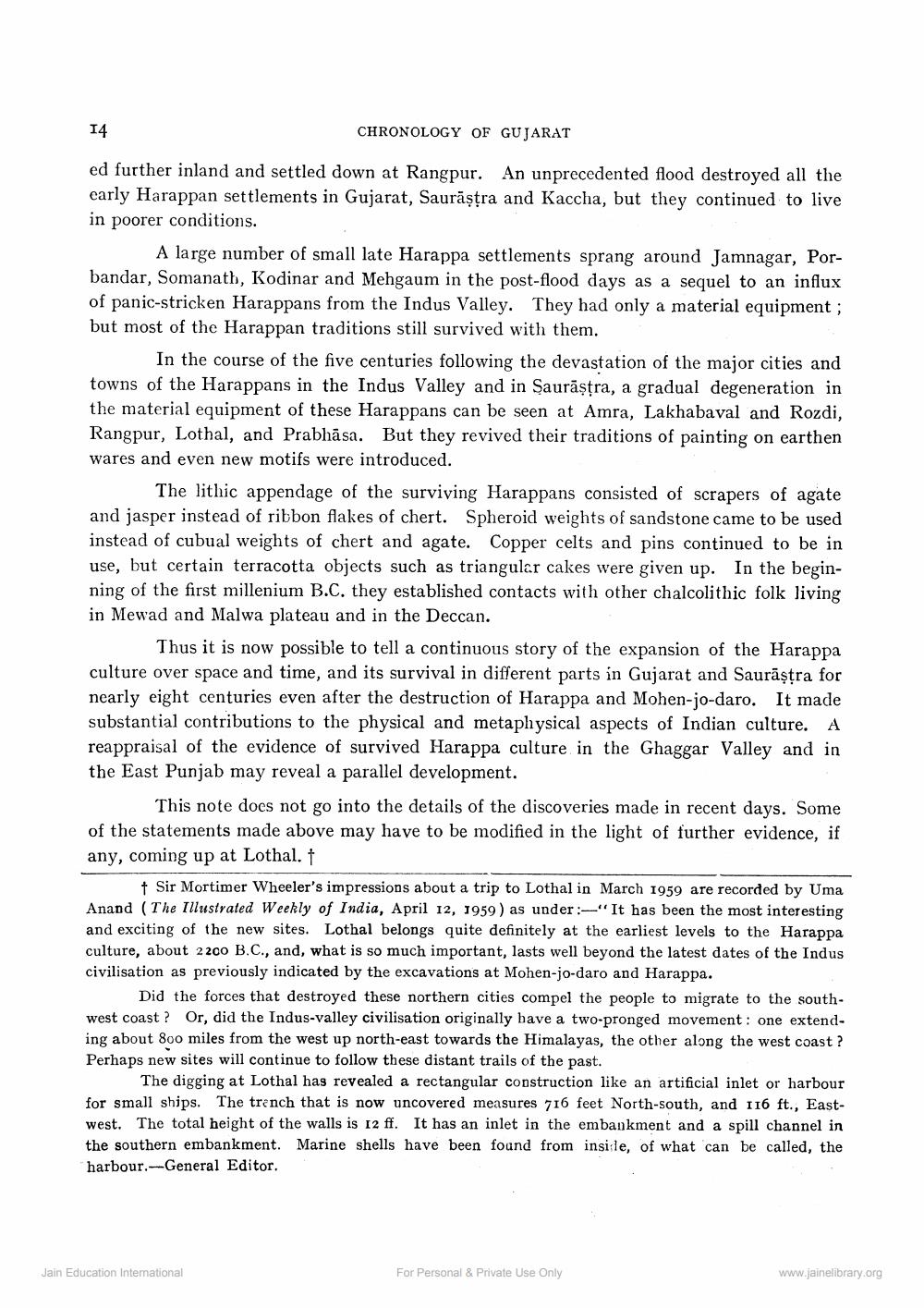________________
14
CHRONOLOGY OF GUJARAT
ed further inland and settled down at Rangpur. An unprecedented flood destroyed all the early Harappan settlements in Gujarat, Saurāṣtra and Kaccha, but they continued to live in poorer conditions.
A large number of small late Harappa settlements sprang around Jamnagar, Porbandar, Somanath, Kodinar and Mehgaum in the post-flood days as a sequel to an influx of panic-stricken Harappans from the Indus Valley. They had only a material equipment; but most of the Harappan traditions still survived with them.
In the course of the five centuries following the devastation of the major cities and towns of the Harappans in the Indus Valley and in Saurāṣtra, a gradual degeneration in the material equipment of these Harappans can be seen at Amra, Lakhabaval and Rozdi, Rangpur, Lothal, and Prabhāsa. But they revived their traditions of painting on earthen wares and even new motifs were introduced.
The lithic appendage of the surviving Harappans consisted of scrapers of agate and jasper instead of ribbon flakes of chert. Spheroid weights of sandstone came to be used instead of cubual weights of chert and agate. Copper celts and pins continued to be in use, but certain terracotta objects such as triangular cakes were given up. In the beginning of the first millenium B.C. they established contacts with other chalcolithic folk living in Mewad and Malwa plateau and in the Deccan.
Thus it is now possible to tell a continuous story of the expansion of the Harappa culture over space and time, and its survival in different parts in Gujarat and Saurāṣtra for nearly eight centuries even after the destruction of Harappa and Mohen-jo-daro. It made substantial contributions to the physical and metaphysical aspects of Indian culture. A reappraisal of the evidence of survived Harappa culture in the Ghaggar Valley and in the East Punjab may reveal a parallel development.
This note does not go into the details of the discoveries made in recent days. Some of the statements made above may have to be modified in the light of further evidence, if any, coming up at Lothal. †
Sir Mortimer Wheeler's impressions about a trip to Lothal in March 1959 are recorded by Uma Anand (The Illustrated Weekly of India, April 12, 1959) as under:-"It has been the most interesting and exciting of the new sites. Lothal belongs quite definitely at the earliest levels to the Harappa culture, about 2200 B.C., and, what is so much important, lasts well beyond the latest dates of the Indus civilisation as previously indicated by the excavations at Mohen-jo-daro and Harappa.
Did the forces that destroyed these northern cities compel the people to migrate to the southwest coast? Or, did the Indus-valley civilisation originally have a two-pronged movement: one extending about 800 miles from the west up north-east towards the Himalayas, the other along the west coast? Perhaps new sites will continue to follow these distant trails of the past.
The digging at Lothal has revealed a rectangular construction like an artificial inlet or harbour for small ships. The trench that is now uncovered measures 716 feet North-south, and 116 ft., Eastwest. The total height of the walls is 12 ff. It has an inlet in the embankment and a spill channel in the southern embankment. Marine shells have been found from insidle, of what can be called, the harbour.-General Editor.
Jain Education International
For Personal & Private Use Only
www.jainelibrary.org




